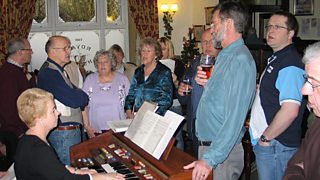Can you identify a backwards carol?
Who doesn’t love a carol at Christmas? The familiar tunes offer a shared musical experience, conjuring up the smell of mince pies and mulled wine, the sight of snowy landscapes on Christmas cards and the feel of that scratch in your favourite Christmas jumper as you settle down in front of the fire.
Have a listen to four short clips made by Radio 3's Choir and Organ programme below and see if you can identify the carols we’re playing backwards on the organ. Some carols are easier to identify than others. You may recognise the tune in some of them, others you’ll recognise by the "feel" of the piece. And you might find the odd clue in the photos...
Listen to each of the clips as many times as you like, and try not to have a sneaky peek at the answers until you think you have them all… or can’t work out what they are.
Click below each of the clips for the answers and share this quiz with your friends and family – challenge them to our Backwards Carols Quiz this Christmas!
Challenge No.1
Let’s start off easy and offer some clues. You’ll find these first three carols in practically every church carol service at Christmas time… probably in this order too!

Carols you hear in every carol concert
We've recorded three carols, backwards, on the organ. Try and guess what they are!
Click here for the answers
O Come all ye Faithful – Originally written as "Adeste Fideles" in Latin, and used as the opener to many a Christmas carol service or concert, usually you’ll only find four English verses of this in your hymn book. However, it can stretch to eight verses. The last verse is always saved for Christmas Midnight Mass and Christmas Day.
While Shepherds Watched – If you’re American you may not recognise the tune we’ve used here, "Winchester Old", which is traditionally used in the UK.
Hark! the Herald Angels Sing – Often used as the final hymn in church carol services, Charles Wesley wrote the piece as "A Hymn for Christmas Day".
Challenge No.2
Here are three carols with just the melody line. Does this make it easier or harder to identify these?

Carols with just the melody line
We've recorded three carols, backwards, on the organ. Try and guess what they are!
Click here for the answers
We Wish You a Merry Christmas – This is probably the most popular doorstep carol, with a simple tune and words, made popular by Arthur Warrell and his Bristol University Madrigal Singers in 1935.
The 12 Days of Christmas – Originally written as a rhyme in the 18th century, it was arranged as a tune in 1909 by Frederic Austin.
Once in Royal David’s City – Traditionally, the first verse of this carol is sung by a young boy chorister or female singer. It’s used as the traditional processional hymn at the Festival of Nine Lessons and Carols on Christmas Eve at King’s College Chapel, Cambridge.
Challenge No.3
If you’ve attended, or taken part in, a children’s carol concert you’ll know these next three carols off by heart.

Carols for kids
We've recorded three carols, backwards, on the organ. Try and guess what they are!
Click here for the answers
Silent Night – This carol was originally written in German ("Stille Nacht, heilige Nacht"), with lyrics by Fr Joseph Mohr and music composed by Franz Xaver Gruber; it was first heard on Christmas Eve 1818 at St Nicholas parish church in Oberndorf, a village on the River Salzach in present-day Austria.
O Little Town of Bethlehem – Phillips Brooks wrote the tune three years after visiting Bethlehem in 1865.
Away in a Manger – A staple in most school nativity plays, it’s been a favourite in carol concerts since its publication in the late 19th century.
Challenge No.4
How well are you doing so far? Have you got all of our carols? Some of these next six might be a little trickier for you, unless they are a favourite with your choir of course!

Some tricky carols often chosen by choirs
We've recorded six carols, backwards, on the organ. Try and guess what they are!
Click here for the answers
The First Nowell – A traditional English carol, its origins are Cornish and it is usually performed as an arrangement in four parts composed by John Stainer.
Coventry Carol – A 16th-century carol, it refers to the story in the Bible where Herod seeks out all male infants in Bethlehem to be killed.
Good King Wenceslas – “Wenceslas” was a fictional king who braved winter and helped the poor on the Feast of Saint Stephen, which we know better now as Boxing Day.
Torches – John Joubert, the composer of this piece, was born in 1927. He wrote this very popular carol in 1951 after moving to the UK from South Africa, to study.
Ding dong! Merrily on High – George Ratcliffe Woodward, the composer, was interested in bell-ringing, which may have helped his writing of this carol, published in 1924.
Hark! the Herald Angels Sing – You already know this was written by Charles Wesley, but did you know that, originally, the first line of the carol was “Hark! how all the Welkin rings”?
-
![]()
With thanks
Our thanks to Stephen Moore, Director of Music at Llandaff Cathedral, for performing the carols on the Nicholson organ. And also to the Dean and Chapter of the Cathedral for allowing us access to record. Sarah Mohr-Pietsch presents Choir and Organ every Sunday at 4pm on Radio 3. Photo courtesy Nicholson & Co.
Enjoyed the quiz?
You can enjoy more much more with Sara Mohr-Pietsch and Choir and Organ this Christmas.
-
![]()
How to stay merry through all those umpteen Ding Dongs and Hark the Heralds...
-
![]()
The Village Carol Tradition
Professor Ian Russell tells us about a carolling tradition that is upheld in Yorkshire.
-
![]()
When carols aren't always what you think
Lisa Colton introduces us to the history of carol singing at Christmas.
-
![]()
Here are some of our favourite, lesser-known carols that we think deserve an outing.





